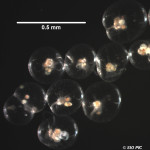
A new blog I discovered, and seem strangely drawn to, is Information Junk, the findings of a San Franciscan librarian. Via IJ, I see that PG&E has agreed to buy power from a “wave park”. No it’s not a water park with lots of tourists creating energy through unspeakable means. Rather it’s eight buoys bobbing in the water 2 1/2 miles offshore of Northern California, each buoy generating electricity as it rises and falls with the waves. The array, schedule for completion in 2012, will produce enough wattage to light 1,500 hundreds homes or 5 during Christmas.







Damn but that diagram is unhelpful. It has three captions:
(1) I think “piston” is more descriptive than “pump”. And the piston stays still while the rest of the housing (filled with air at the top) moves up and down with the waves, rather than what they show (which is the relative motion).
(2) Seawater does not “compress” — it is put under pressure. I would have said that the piston forces seawater up and down through the turbine.
(3) Seems okay. That makes 1 for 3.
The youtube videos are pretty cool though.
I’m not an expert on how ocean waves this distance from shore are generated — is it mostly tidal forces or wind? Assuming it’s tidal, this is a generator which extracts useful gravitational energy from the Earth-Moon system (as opposed to a waterfall which only extracts it from Earth). Cool!